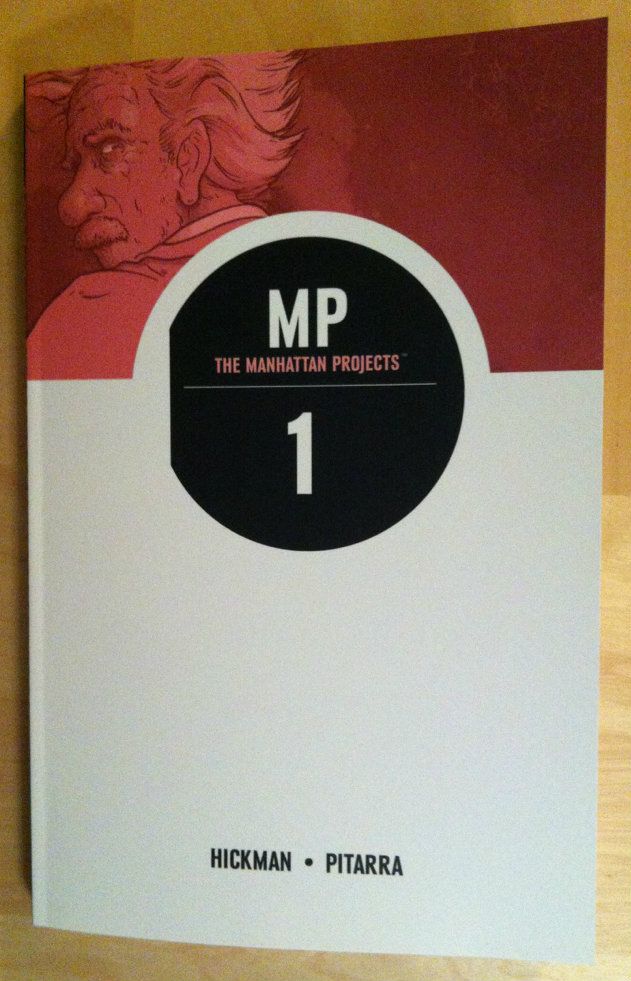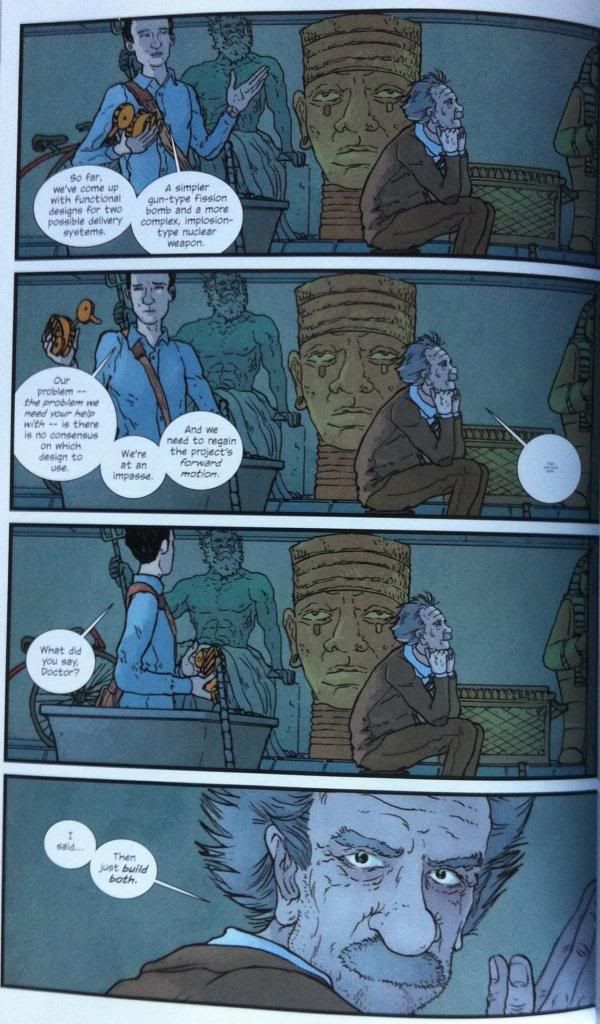Or the moment that destroyed me and its historical context in The Manhattan Projects: Volume One
By Jonathan Hickman, Nick Pitarra, and Jordie Bellaire; Image Comics
Before The Manhattan Projects took a sharp turn to completely fantastical, gruesome Mad Science, it briefly flirted with the real life history of The Manhattan Project and the development and deployment of the Atomic Bomb. The chapter of Volume One, The Bomb, which tells an alternate story of bombing Hiroshima, is one of the most tense, arresting single issues of comics I have ever read: the way it plays with true history and the bizarre carnival mirror of the comic is profound and horrifying and a thought provoking look at the intersection between Science/Technology and Society/Politics. (You really ought to read it; if I were teaching a Philosophy of Science class I'd make my students read it.) That said, there is a single moment in tThe Bomb that is so rip-out-your-heart perfect that I still think about it more than a year after reading it. And I would like to explain why.
This post will have *SPOILERS* for Manhattan Projects: Volume One. Be warned.
In this sequence amoral-mirror-Richard Feynman goes to evil-parallel-universe-doppleganger-Albert Einstein with the engineering question of whether the Manhattan Projects should focus on constructing a relatively simple "gun-type" nuclear fission bomb, or a more complex "implosion-type" device. The part of this that resounds with me and absolutely guts me, is that not-Einstein replies simply that they should "just build both".
Which is just so completely fucking, oh my god brilliant and awful and perfect.
Because the real-life Manhattan Projects really did build both.
The thing about nuclear bombs is that they are perversely simple. For a nuclear fission explosion, all you need is enough stuff, a sufficiently massive lump of high purity fissionable material will undergo a runaway nuclear chain reaction and explode. So all a nuclear fission device is, is a machine that takes a chunk of radioactive material which is too small to have this exponentially growing nuclear reaction and pushes it over the mass threshold needed to explode. The simplest way to do this is to hold two chunks of fissionable material apart, and then rapidly stick them together to make a big enough chunk to blow up. And this is literally what a gun-type device is.
The real challenge of nuclear bombs is the fuel for the explosion. Naturally occurring high quality fissionable material is exceedingly rare, and even then the most reactive isotopes have to be painstakingly separated from slightly more common less or un-reactive isotopes. Many of the better nuclear fuels are not naturally occuring in sizeable amounts and have to be produced in labs, usually using other nuclear reactors. (Incidentally a bunch of super important medical isotopes are becoming increasingly rare as many countries shut down their reactors.) So the real life history of The Manhattan Project is shaped by the history of the production and availability of high quality radioactive isotopes.
Initially, the project lacked sufficient pure radioisotopes of any kind of fuel to build any type of bomb. However, the project did have access to naturally occurring Uranium from a variety of mines and over time developed the a technique to separate desirable Uranium-235 from the inert, majority Uranium-238. This meant that The Manhattan Project had the capability to construct an enriched-Uranium nuclear device. Because the The Manhattan Project was in a rush to build atomic weapons to use in the war, they opted to keep it simple, and build a gun-type device that shoots a small chunk of U-235 into a larger chunk to set off an explosion. This is the first bomb they built called the Thin Man and later, The Little Boy.
However, during development of this first bomb, a new, better fuel source, Plutonium, became available. While The Manhattan Project was developing the bomb, another portion of the project was developing nuclear reactors. Some nuclear reactors make, as a byproduct of fission, plutonium, which is a higher energy fissionable material and so useful amounts of Plutonium became available to The Manhattan Projects. (Science brag: Ive held a warm sphere of lead lined Plutonium in real life.) However, Plutonium did have one other problem: it was too reactive to be used in a gun-type device. A gun-type Plutonium device would "fizzle" by tearing itself apart before a significant amount of the bombs fuel could be reacted, and so the device would lead to a much smaller explosion. And so the real-life Manhattan Project was forced by engineering reasons to develop an implosion style device that basically crushed a ball of Plutonium into a dense enough ball to set off an exponentially growing nuclear reaction and explosion. Trinity and The Fat Man were this type of bomb.
The thing is, this device was, by comparison to the gun-type device, super complicated so The Manhattan Project was not willing to suspend the development of the simpler Uranium gun-type device. So in the end, they built both a gun-type bomb and an implosion-type bomb.
And then they fucking used both.
The bomb the US dropped on Hiroshima Japan was The Little Boy, a uranium gun-type device. The bomb they dropped on Nagasaki three days later was Fat Man, a plutonium implosion-type device. In real life, they built both types of bomb and USED both types of bomb.
And that is at once a perfectly logical, practical Science and Engineering decision and excruciatingly horrifying.
With this real life context, this line by evil-Einstein is just so perfect and so completely awful. This moment encapsulates the mercenary practicality of the decision to develop both devices, the near sociopathic disregard for the consequences of this choice, and the inevitable finality of this decision. It's a carnival mirror reflection of the frigid, inhuman extremes of Science and Engineering.
And so it sticks with me.
Previously:
The Manhattan Projects: Volume 1
The Manhattan Projects: Volume 2



No comments:
Post a Comment